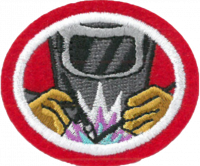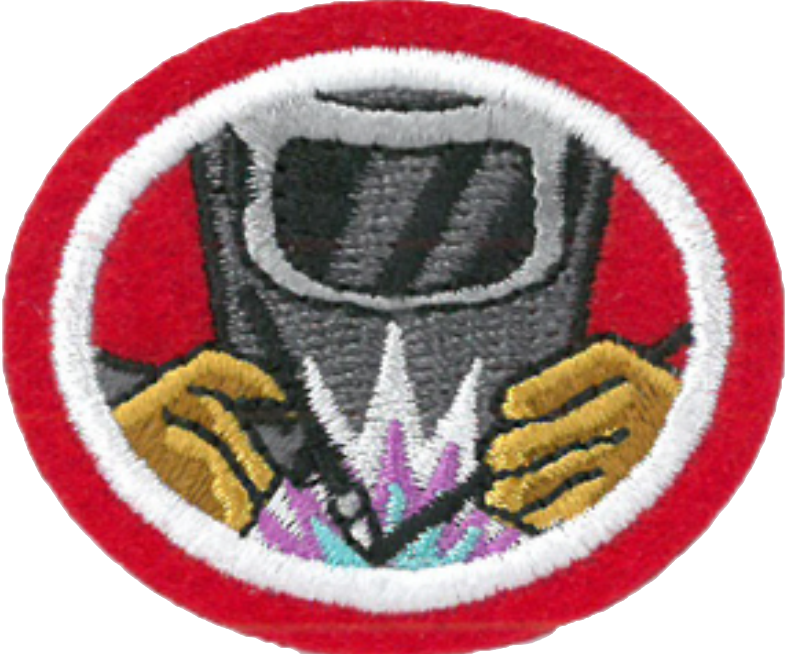|
|
| Line 77: |
Line 77: |
| | {{clear}} | | {{clear}} |
| | | | |
| − | <div lang="en" dir="ltr" class="mw-content-ltr">
| + | {{clear}} |
| − | ====PROCEDURE:====
| |
| − | </div>
| |
| | | | |
| − | <div lang="en" dir="ltr" class="mw-content-ltr">
| + | {{clear}} |
| − | Setting up the torch:
| |
| − | </div>
| |
| | | | |
| − | <div lang="en" dir="ltr" class="mw-content-ltr">
| + | {{clear}} |
| − | # Make sure the regulator adjusting screws on both the oxygen and acetylene regulators are backed out fully counter – clockwise
| |
| − | # Open the acetylene cylinder valve ¼ to ½ turn
| |
| − | # Open the torch acetylene valve about ½ turn. The acetylene valve lines up with the red hose
| |
| − | # Turn the acetylene regulator adjusting screw clockwise until 5 pounds pressure is read on the low pressure gauge
| |
| − | # Close the torch acetylene valve
| |
| − | # Open the oxygen cylinder valve all the way until the valve stops<br>Stand out of the way of the gauges when opening the oxygen bottle to prevent serious injury if the regulator valve fails
| |
| − | # Open the torch oxygen valve about ½ turn<br>The oxygen valve lines up with the green hose
| |
| − | # Turn the oxygen regulator adjusting screw clockwise until 5 pounds pressure is read on the low pressure gauge
| |
| − | # Close the torch oxygen valve
| |
| − | # Before lighting and using the torch, check the system for leaks
| |
| − | # Close the cylinder valves. If a cylinder gauge shows a pressure drop, there is a leak.
| |
| − | # If a leak is indicated, listen, smell and touch around all fittings and hoses, or use soapy water to find the leak.
| |
| − | </div>
| |
| | | | |
| | | | |
| − | <div lang="en" dir="ltr" class="mw-content-ltr">
| + | {{clear}} |
| − | ====LIGHTING & ADJUSTING:====
| |
| − | </div>
| |
| | | | |
| − | <div lang="en" dir="ltr" class="mw-content-ltr">
| + | {{clear}} |
| − | *Proper eye protection must be worn (shaded torch welding / cutting glasses)
| |
| − | *Proper non – flammable coveralls must be worn
| |
| − | *Remove butane lighters from pockets
| |
| − | </div>
| |
| | | | |
| | | | |
| − | <div lang="en" dir="ltr" class="mw-content-ltr">
| + | {{clear}} |
| − | # Put on proper eye protection and protective clothing
| |
| − | # Open the torch fuel valve no more than ½ turn
| |
| − | # Position the tip of the torch down and away from your body and hold the striker in your other hand so only the head of the striker is in front of the torch tip<br>Practice using the striker with the fuel shut off
| |
| − | # Use the striker to light the torch<br>Never use a lighter, matches, or other burning material to light the torch
| |
| − | # Adjust the torch fuel valve until the flame gives off little black smoke
| |
| − | # Slowly open the torch oxygen valve to create a neutral flame
| |
| − | </div>
| |
| | | | |
| − | <div lang="en" dir="ltr" class="mw-content-ltr">
| + | {{clear}} |
| − | Neutral flame: (equal amounts of oxy/acetylene) has a rounded white inner cone used for fusion welding steel.
| |
| − | </div>
| |
| | | | |
| − | <div lang="en" dir="ltr" class="mw-content-ltr">
| + | {{clear}} |
| − | Carburizing flame: (less oxygen) has a longer feathered blue inner cone a slightly carbonizing flame is used for brazing.
| |
| − | </div>
| |
| | | | |
| − | <div lang="en" dir="ltr" class="mw-content-ltr">
| + | {{clear}} |
| − | Oxidizing flame: (excessive oxygen) has a short pointed white inner cone used for special purposes such as brazing with bronze filler rod.
| |
| − | </div>
| |
| | | | |
| − | <div lang="en" dir="ltr" class="mw-content-ltr">
| + | {{clear}} |
| − | ====SHUTTING DOWN:====
| |
| − | </div>
| |
| | | | |
| − | <div lang="en" dir="ltr" class="mw-content-ltr">
| + | {{clear}} |
| − | # Shut off the torch fuel valve first, which immediately extinguishes the flame
| |
| − | # Shut off the torch oxygen valve
| |
| − | # Close the acetylene cylinder valve
| |
| − | # Close the oxygen cylinder valve
| |
| − | # Bleed the acetylene line by opening the torch acetylene valve until the pressure reads zero on both the high and low pressure gauges<br>(If the torch will be left for more than a few minutes and then reused, both lines must be bled before lighting the torch again)
| |
| − | # Turn the acetylene pressure regulating screw counter – clockwise all the way out
| |
| − | # Close the torch acetylene valve
| |
| − | # Bleed the oxygen line by opening the torch oxygen valve until the pressure reads zero on both the high and low pressure gauges
| |
| − | # Turn the oxygen pressure regulating screw counter – clockwise all the way out
| |
| − | # Close the torch oxygen valve
| |
| − | </div>
| |
| | | | |
| | <div lang="en" dir="ltr" class="mw-content-ltr"> | | <div lang="en" dir="ltr" class="mw-content-ltr"> |
| Line 162: |
Line 113: |
| | </div> | | </div> |
| | | | |
| − | <div lang="en" dir="ltr" class="mw-content-ltr">
| + | {{clear}} |
| − | This requirement demonstrates one's skill in working in darkness, such as in an emergency. All acetylene connection threads are left-handed, while all oxygen connection threads are right-handed.
| |
| − | </div>
| |
| | | | |
| | <noinclude></noinclude> | | <noinclude></noinclude> |
| Line 190: |
Line 139: |
| | <!-- 7. Explicar las precauciones de seguridad y el equipo de seguridad normalmente utilizados en soldadura eléctrica en relación a los ojos, las manos y zonas de la piel expuesta. ¿Por qué no deberían las válvulas de los tanques ser aceitadas? --> | | <!-- 7. Explicar las precauciones de seguridad y el equipo de seguridad normalmente utilizados en soldadura eléctrica en relación a los ojos, las manos y zonas de la piel expuesta. ¿Por qué no deberían las válvulas de los tanques ser aceitadas? --> |
| | | | |
| − | <div lang="en" dir="ltr" class="mw-content-ltr">
| + | {{clear}} |
| − | ===SAFETY EQUIPMENT===
| |
| − | </div>
| |
| | | | |
| | <div lang="en" dir="ltr" class="mw-content-ltr"> | | <div lang="en" dir="ltr" class="mw-content-ltr"> |
| Line 198: |
Line 145: |
| | </div> | | </div> |
| | | | |
| − | <div lang="en" dir="ltr" class="mw-content-ltr">
| + | {{clear}} |
| − | * Wear shaded safety glasses
| |
| − | * Use gloves during torch operation and when handling hot metals
| |
| − | * Follow all safety rules for this and all other equipment
| |
| − | </div>
| |
| | | | |
| − | <div lang="en" dir="ltr" class="mw-content-ltr">
| + | {{clear}} |
| − | ===OXY-ACETYLENE SAFETY===
| |
| − | </div>
| |
| | | | |
| − | <div lang="en" dir="ltr" class="mw-content-ltr">
| + | {{clear}} |
| − | * You must be trained and authorized before using the oxy-acetylene torch
| |
| − | * Make sure you do not have a lighter in your pocket – they can explode!
| |
| − | * Ensure gas bottles are upright and secure at all times
| |
| − | * Do not allow oil or grease to come in contact with hoses or equipment
| |
| − | * Perform all welding and cutting in the welding area – ventilation must be turned on
| |
| − | * Approved goggles and spark resistant clothing must be worn when using the oxy-acetylene torch
| |
| − | * Do not weld or cut a closed container
| |
| − | * Make sure the work area is clear
| |
| − | * Open the cylinder valves slowly – stand to the side!
| |
| − | * Light the torch with the striker – do not use a match or a lighter
| |
| − | * When welding, bend the end of the rod to identify the hot end and to prevent eye injury
| |
| − | * When finished turn off the torch valves, turn off cylinder valves, then go back to the torch and bleed both lines
| |
| − | * Keep the cylinder caps on when not in use
| |
| − | </div>
| |
| | | | |
| | <noinclude></noinclude> | | <noinclude></noinclude> |


